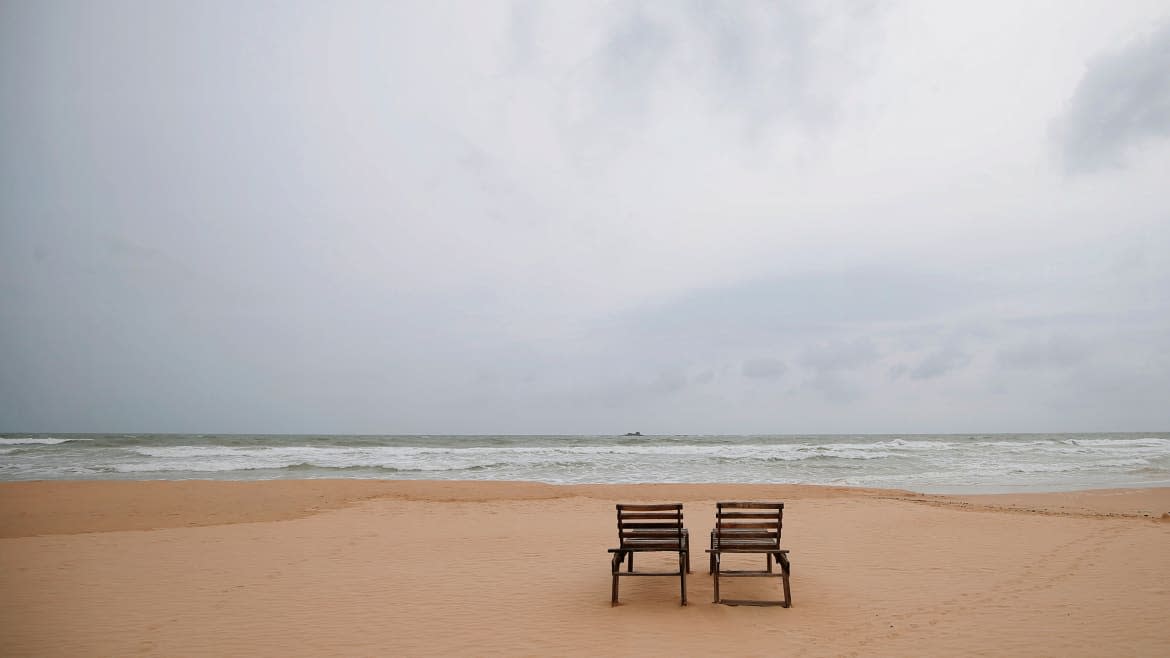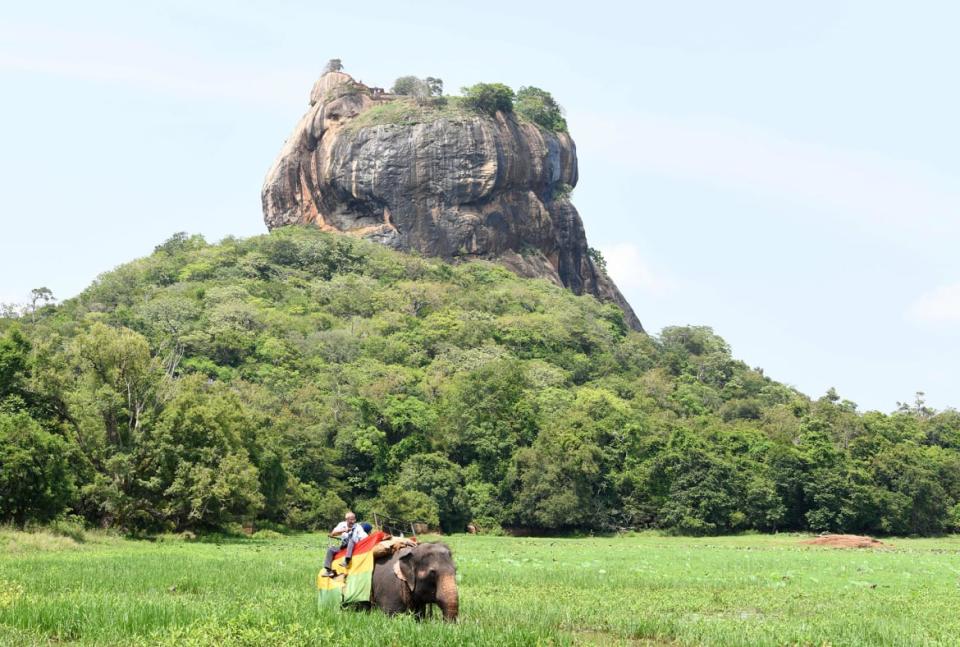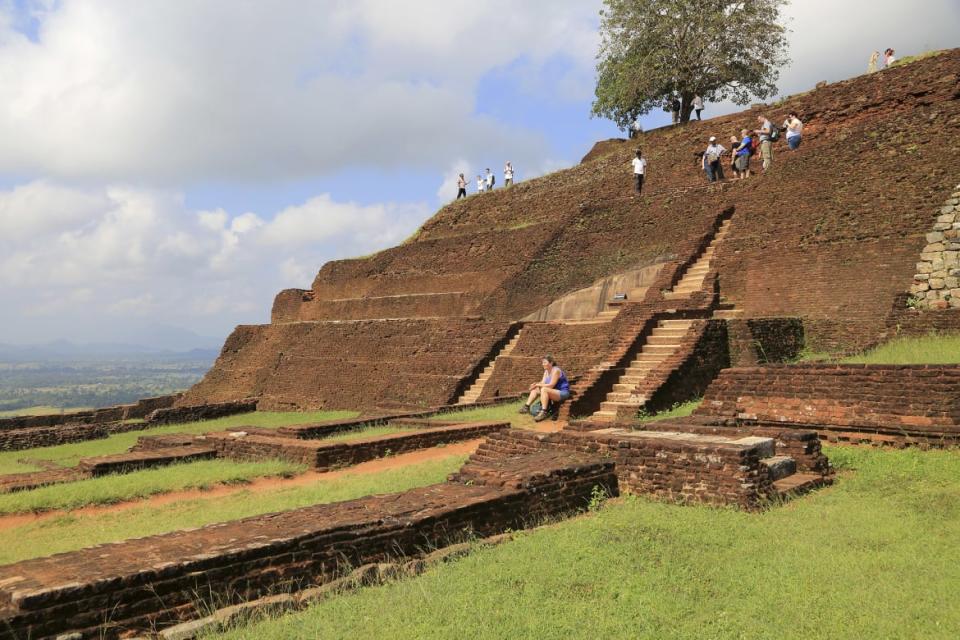Sri Lanka Was One of the World’s Hottest Destinations. Now It’s Eerily Empty.

Having landed a few minutes earlier here at Colombo’s international airport, our jam-packed flight from the Maldives is disembarking its crammed cabin, passengers marching down the arrival ramp under the watchful eyes of camouflaged police, standing easy in flak jackets, but hands firmly fixed on their automatic weapons.
It’s all very calm, straightforward, businesslike. Everyone knowing what they’re doing—where they’re headed.
In a moment, passengers are faced with a choice.
To the right—Connections—all the planes, already lined up on the tarmac and waiting to fly people off this island to Jeddah, and Doha, and points beyond. To the left—Arrivals—and then immigration, and the wonders of Sri Lanka, a country, that until recently, enjoyed a burgeoning tourism industry and topped many international lists of Where to Go in 2019.
As we reach that intersection, I’m the only one who turns left, a lone single passenger leaving the pack, approaching immigration desks with no queues, staffed with sleepy-looking officers.
In one moment—or a simultaneous string of them, really—everything changed on this island nation. A decade after concluding a 30-year civil conflict, Sri Lanka had, until a couple weeks ago, enjoyed unprecedented peace and surging prosperity. But on Easter Sunday, a series of targeted blasts across the island shattered all that, tearing open old wounds and returning the country to a familiar war footing.
I was actually in Sri Lanka during the Easter Sunday attacks, staying in the coastal city of Negombo, one of the hardest hit communities. After leaving the country and knocking around South Asia for a couple weeks, I decided to come back, to see the Sri Lankan situation, and experience a little more of this place. Exiting the security cordon around the airport, and climbing into a van driven by the gregarious Jayaweera—a friend of a friend—I'm told that after a high season of soaring occupancies and chock-a-block tours, the bottom has now dropped out, entirely.
Literally, everybody canceled. “My friend, a guide, he had a group of 178 Italians booked and none of them came,” he says, shaking his head with a sardonic smile. “And you—you’re my first pickup this month.”
We wind through the usually frenzied streets around the capital, Colombo, headed south to the coast. While it’s busy, Jayaweera tells me that it should be busier. Eventually we pass the historic fortified city of Galle, built by the Dutch, Portuguese, and English, and head down the coast, where Jayaweera drops me at The Fortress Hotel, a landmark, 53-room resort with a massive pool lined with (mostly empty) deck chairs leading straight out to the beach, and the crashing waves of the Indian Ocean. Later, sitting down to dinner at a lovely, but nearly empty, open-air restaurant—the few diners caressed by the sea breeze, ceiling fans spinning—I join three young women, Anosha, Bianca and Sina, at their table.

Sri Lankan tourists ride on an elephant during a sightseeing tour in the ancient Sri Lankan city of Sigiriya, about 100 miles north of Colombo.
Anosha owns a surf villa where Bianca, a South African, has worked for three months and Sina, a Swiss national, has been a guest since before the attacks. They tell me that this is one of their favourite local restaurants, and it’s usually packed—hard to even get a seat. Not so much, now.
I ask them why, with everything going on, they stayed? “Where else should I go?!,” Sina says, defiantly. “London, New York, Paris? This could happen anywhere!”
The women note that nothing has changed here in Sri Lanka’s tropical southwest corner—no trouble, no violence at all. All of that, just up the road in Colombo, feels like it’s a million miles away. The only noticeable difference is the exit, en masse, of all the tourists.
Chatting the next day with Don Wikeskara, a manager at the hotel, he adds that, using lessons they learned during the country’s long civil war, police and military quickly secured the country. Now, Singhalese and Tamils are united to stamp out this threat. “Our combined forces are the strongest in the world. And if you’re willing to take your home country’s travel warnings with a grain of salt, now is actually an excellent time to visit.” Room rates have dropped dramatically. And you’ll never have to fight for a deck chair by the pool.
I see that the next day, as I climb into a tuk-tuk with a guy named Atilla, who takes me into the Old Fort at Galle, built by the Portuguese in 1588 and modified into its current form by the Dutch in the 17th century. On the way, he shows me various attractions—stilts, poking out of the shallow water, used by traditional fishermen, brightly painted fishing boats, a turtle hatchery. Everywhere, the beaches remain completely empty. Atilla speaks three languages, including German, but even the German tourists, usually a hardy, fearless sort, are staying away. He notes that the community is heavily invested in tourism—since the end of the war, people have built guest houses and small restaurants. “Everyone is playing a small part,” he says.
Entering through the fort’s main gate, a half-dozen national policemen armed with assault weapons check us over—Atilla has to show ID, and they peek at me, sitting in the back—but it’s all very relaxed, almost friendly. Fixing a rendez-vous time and place for the return trip, I set out on my own, proceeding past galleries and hotels and restaurants and cafes—every one of them, empty. Taking a little tour of a new boutique hotel, the manager tells me they have 18 rooms, and they were all full before the attacks. “Now, we have one person in house, a guy down in room seven.”
Climbing up the ramparts, I walk along the seawall to the still-operating lighthouse, added by the English in 1939, then double back to trace the edge of the fortifications—old stone blocks, much of it covered in rolling grass, sharp drops to the sea. Around the bend, I find few tourists—just a tiny trickle, I spot maybe 10 in total all night, in a place that attracted them like flies, by the hundreds, before the bombing.
But that doesn’t mean it’s empty. Everywhere, local couples and families have come out to enjoy the cooling weather and the sunset. A group of older boys play a spirited game of pick-up cricket on a grassy hill. Aided by his dad, a small boy flies a kite. A family with three young girls cram onto a bench together to eat sandwiches. People dive into the Indian Ocean to cool down.

Buildings of rock palace fortress on rock summit, Sigiriya, Central Province, Sri Lanka.
A little further down, a group of friends from Negombo—where my adventure started—gather to take photos of a couple who will be married next week. Their friend, Steshani, sitting nearby, tells me that, unlike the many arranged marriages here, this is a love marriage—that they have chosen each other. “They want to make a true expression of it,” she says, as the soon-to-be-bride-and-groom smile, and form a heart with their hands, wrapping it around the rapidly setting sun.
Inevitably, we talk politics, and about the future of the country. Steshani is hopeful. She points to the unity and diversity that have long persisted here—that Christian and Buddhist and Muslim and Hindu and Tamil and Singhalese live together side-by-side, mostly peacefully. “We have only one Sri Lanka, and it is ours,” she says, firmly. “We don’t have anywhere else. This is our country. We cannot lose it—no, not now.”
Get our top stories in your inbox every day. Sign up now!
Daily Beast Membership: Beast Inside goes deeper on the stories that matter to you. Learn more.

